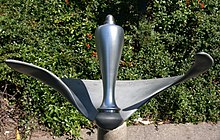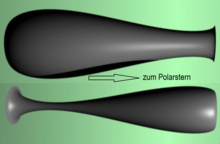Bernhardt roller
A Bernhardt roller is a specially shaped pole rod of a ring-shaped equatorial sundial that enables the mean solar time to be read .
history

The original idea for such a pole rod, with which the equation of time is included in a sundial , so that one reads not the true but the mean solar time, comes from the British Lieutenant General John Ryder Oliver (born December 16, 1834 in Ashby de la Zouch , North West Leicestershire in England, † February 10, 1909 in Feltham , London). His pole rod roller was patented in 1892 (British Patent # 1660). His daughter gave the London Science Museum a prototype of her father's sundial in 1932 (made by Negretti and Zambra), which is still on display there today.
The German technician and watchmaker Martin Bernhardt (born April 6, 1919 in Freudenstadt , † January 28, 2001) dealt with this idea during his Soviet captivity. Bernhardt first built such a sundial in 1966 for a competition organized by Sky and Telescope magazine ; it was published in it as one of the three best designs. An accuracy of 1 minute is only achieved with the Bernhardt design, i.e. one scale division per minute makes sense. In 1992 he passed his sundial patent on to watchmaker Werner Schreiner .
Today there are around 150 sundials of this type in public places around the world.
function

sundials with cylindrical dials and Nodi as a shadow thrower (one sundial each for one half-year).
In the case of the equatorial sundial with a cylindrical dial (earth axis parallel cylinder axis), the straight hour lines can be replaced by hour loops ( analemma figures) and the time can be read from the rod shadow, taking into account the equation of time. If the shadow rod ( pole rod ) is replaced by a node , reading is simplified. So that there is no danger of confusing the two half-years when reading, the hourly loops are often divided (see the adjacent illustration of a double-cylinder sundial.)
Bernhardt has carried out a change of elements : two shadow throwers (rollers) , which are replaced every six months, each have the contour of a half-hour loop, and the dial has become a number ring (outer edge of the dial). The reading point on the number ring comes from the mode contained in the roller contour, with the date running "upwards" (first half year) or "downwards" (second half year).
The time is always read from the leading shadow edge.
The rollers are created by rotating the respective half analemma around an axis outside the (not axially symmetrical) analemma.
Web links
- G. Glaeser, W. Hofmann: About minute-accurate sundials for the mean time. Geometry information sheets. Issue 2/2004, Volume 23, pp. 40–46 ( PDF file ).
- Bernhardt sundial: website of the manufacturer [1]
Remarks
- ↑ The main claim of Bernhardt's patent is the shape of the graduated ring.
- ↑ The dial does not have to be scaled with the sun declination or the year date.
- ↑ Instead of doubling, there is also the option of replacing the dial every six months.
Individual evidence
- ↑ SundialsCHRONOS history , on helios-sonnenuhren.de, accessed on May 1, 2019


